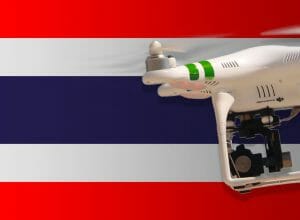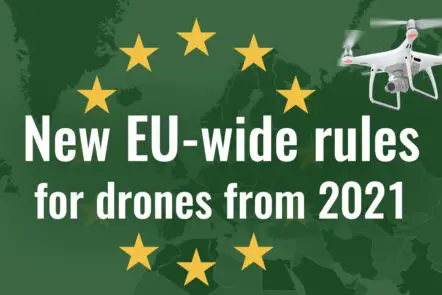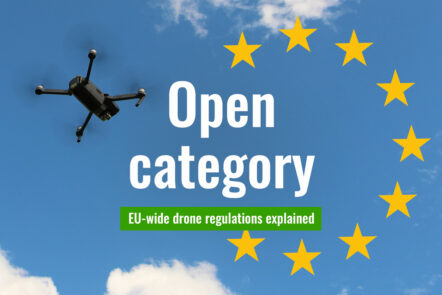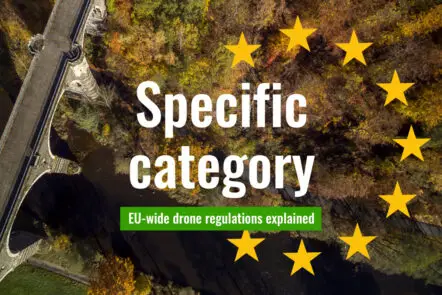Drone regulations in Thailand (2024)
Last update on 04.04.2024 | 501 Kommentare

If you want to fly a drone in Thailand, you will have to take some hurdles. In this article, I explain to you the conditions you have to fulfill.
In recent years, the rules for drone pilots in Thailand have changed quite often. This creates a lot of confusion and not all the information you can find on the internet is up to date. I am trying to give you a current and complete overview of the legal situation in the Kingdom.
First of all, if you are caught drone-flying without the necessary permits, you face high fines and even imprisonment. Thai prisons are not fun!
For most camera drones, you need two registrations: First, from the National Broadcasting and Telecommunications Commission (NBTC), which handles the frequencies used by the drone. Second, by the Civil Aviation Authority of Thailand (CAAT), which registers all drone pilots.
So far it is not possible to complete the registrations before going to Thailand. This means you will need some luck to get your documents in time. In the following I explain to you how the procedures at NBTC and CAAT work.
Overview: Drone rules in Thailand
Drone labels can be ordered here
CAAT: 0066 (0) 2568 8815
Registration of drones in Thailand
In total, you need three documents to fly legally in Thailand: drone insurance, NBTC registration and CAAT registration. You should have these documents with you during all drone flights.
Get insurance
The insurance confirmation should be in English and contain the following data:
- full name of the policyholder
- brand, model, serial number and weight of the insured drone(s)
- validity in Thailand must be clear
- insurance coverage of at least THB 1 million (approx. EUR 30,000)
Register with the NBTC
Before the Corona pandemic, you had to go to one of the NBTC offices to register. Fortunately, this process has finally been digitized, so you can at least prepare this step before your trip to Thailand.
First you create an account here. After your email address has been confirmed, you can enter your contact details and your address in Thailand. However, the actual registration of your drone requires a photo of the entry stamp you receive in your passport upon arrival. Therefore, you can actually only complete the NBTC registration in the country. According to some experiences from our community, you can upload your e-ticket for the flight to Thailand instead of the entry stamp.
The cost of drone registration with the NBTC is about 200 baht and must be deposited at a Thai bank. A good place to start is Krung Thai Bank. The deposit of the NBTC fee cannot be done at all Thai banks.
If you fail to register with the NBTC and are caught by the police, you could face up to five years in prison or a fine of 100,000 THB (approx. 3,000 euros).
Register with the CAAT
You have to register your drone with the CAAT if it has a camera/recording equipment or – if it does not have recording equipment – weighs more than 2 kg.
You can only register with the CAAT once you have the approval of the NBTC. Since summer 2018, registration has been possible via the online platform uav.caat.or.th.
The relevant fields have been translated into English so that you should be able to fill out the forms quite easily. You will have to provide a lot of personal information during the process. In addition, you have to upload a signed self-declaration, a picture of the drone with the serial number on it and proof of your drone insurance. In addition, the CAAT requires a copy of your passport with the entry stamp. Several of our readers received rejections due to the lack of proof of entry. This means that you can only register once you have already entered the country.
Update: Since February 2022, we have repeatedly received feedback that the CAAT has accepted the registration even before entry and without confirmation from the NBTC. Instead of the photo with the entry stamp, some applicants uploaded a photo of their passport again and this was accepted. However, there are still other experiences. We still encourage you to try the CAAT before your trip and keep us informed about your experiences. Thank you very much for doing so!
After you have submitted the complete documents, the CAAT will check your application and carry out a background check with several security authorities to ensure that you have not yet committed any legal violations in Thailand. Since this can be very time-consuming, you have to expect a long processing time. The CAAT writes on its website that you will receive a notification within 15 working days. In practice, it can be shorter, but it can also take much longer. The good news is that if your registration was successful, it is valid for two years.
If you are caught flying without CAAT registration, you face up to 1 year imprisonment and / or 40,000 THB penalty (approx. 1,200 euros).
Frequently asked questions about drone rules in Thailand
I would like to answer the questions most commonly asked in the comments here:
- Do I have to register my DJI Spark / DJI Mavic Pro / … for my Thailand vacation?
Yes, because these drones have a camera. You can find more information above. - I am only visiting Thailand in transit and do not want to start my drone in the country. Can I get in trouble if I have no registration?
There should be no problems. Customs are not interested in drones, and the registrations are only required for the operation of unmanned aerial vehicles. However, there may be issues if the authorities get the impression that you want to resell the drone in Thailand (for example, if you import the drone in its original sealed packaging). - I am flying to Thailand in a few weeks/days and would like to take my drone with me. Now I have read that I have to register. What can I do now?
You should take out drone liability insurance and collect the above documents. At the moment you can only register if you are already in Thailand. But keep in mind that processing your application can take weeks and you may not receive your permits in time if you are in the country for only a short vacation. - How long does it take to register with the CAAT?
This varies and also seems to depend on the number of current applications. You can avoid a very long processing time by submitting all documents on time. Please keep in mind that processing at CAAT will only begin once you have approval from the NBTC.
Further regulations for operating multicopters in Thailand
After you have successfully registered yourself and your drone, there are of course other rules to follow
If you want to fly privately and no camera is mounted on your drone, the maximum take-off weight is 2 kg. With a higher weight you need approval from the CAAT. Drones weighing 25 kilograms or more need a separate permit from the Ministry of Transport.
Commercial pilots need permission for their flight maneuvers.
Safety distances and flight bans
You have to keep a distance of 9 kilometers (= 5 miles) to airports.
You can’t get closer than 50 meters to people, vehicles and buildings.
You must not fly near crowds of people. Flying over cities and villages is not allowed. Also avoid government buildings and hospitals.
You must always obtain permission from the property owner to take off and land. In practice, we usually solve this by asking the guards for permission or by asking at the information desk.
Your drone must always be kept within visual line of sight.
Drone flights are only allowed in daylight in Thailand, i.e. between sunrise and sunset.
The Thai rules also stipulate that you have an emergency plan. This includes having to carry a fire extinguisher with you. We have not yet found out whether this rule is enforced.
Good to know: Flights in Chiang Mai must be generally approved by air traffic control because the airport is so close to the city. We have obtained the appropriate permission. But you should call a few days before so that the people in the tower can coordinate with their bosses. Also, for flights over the historic park of Ayutthaya, approval is necessary. The Historical Park Office grants the permission, which is open daily from 8:30 to 16:30. According to the tourist information, the permit costs 5,000 baht.
We have researched the listed drone regulations for Thailand to the best of our knowledge. We cannot guarantee the correctness of the information. If you want to be on the safe side, contact the Thai aviation authority. Alternatively, you can also ask the Thai embassy in your country for further information about the regulations. Please leave us a comment when you receive news and/or gain experience with your copter in Thailand!
 EU-wide drone regulations: Classes of drones explained
EU-wide drone regulations: Classes of drones explained
 New EU-wide rules for drones from 2021
New EU-wide rules for drones from 2021
 EU-wide drone regulations: The Open category explained
EU-wide drone regulations: The Open category explained
 EU-wide drone regulations: The Specific category explained
EU-wide drone regulations: The Specific category explained
I’ve just received my CAAT certificate in advance before travelling to Thailand and with a very cheap 1 month only insurance !
I will apply for the NBTC one I’m in Thailand as I will need the entry stamp 👍
Where did you buy the drone insurance and how much did you pay???
I wanted to point out that I also received CAAT registration prior to arriving in Thailand. It is the NBTC that causes a challenge because it does actually require the passport stamp and to be in the country. My suggestion is have all your images, documents and everything lined up prior to arriving in Thailand and then as soon as you arrive in Thailand, submit the application for NTBC. The CAAT is good for 2 years, NBTC is based upon your visa or time in Thailand. For example Visa on arrival from USA will be 30 days of NBTC registration. You can renew (extend) it in the case you get a visa extension.
Opensky app is very helpful as you can submit a request to fly directly to the authorities and receive permission within a day or two but initial registration for OpenSky app takes a few days. The challenge with opensky app is, let’s say for example you want to fly along the river near icon Siam or in the middle of Sukhumvit – ok cool no problem. However, you must get written permission from property to be able to submit request on opensky app. So it’s like this – get written permission from property, take picture of the permission document, include that image of document along with outline of flight path, flight ceiling, time of day, duration of flight, etc., you will see the app has boxes for information it requests from you. Then you upload all that, wait a day or two and receive approval to fly. Then you are good. I have done this directly over Sukhumvit and I launch from my condo roof. My landlord gave me permission in writing, I submit and no problem. The challenge lies in that many Thais are unaware of drone laws and instead of saying I don’t know they try to tell you to call the police or they give excuses such as “the embassy is nearby” or something. There needs to be education on this matter because so much more awesome YouTube content and great videos could be in existence if people who are like myself, who don’t want trouble and to just be able to fly legally, could get easier approvals to fly because people are aware of the process of drone operations. But they are not.
Anyway, I would like to point out that currently opensky app is only really available in and around bangkok. Phuket and Krabi, up north and Issan regions are totally different. No opensky app. Still need NBTC, still need CAAT, insurance, fire extinguisher etc. but mostly just ask front desk/security guard permission, you’re good to go.
I have a Dji Mavic Air and friends in Thailand tell me it is to old to register so cannot be flown there. Can anyone advise if this is correct please.
Thanks in advance.
Adrian
Ok I am confused a bit. I have a couple of small drones with NO CAMERA and less than 2kg.
What is the process for these. Do I still have to register with NBTC, but not CAAT?
What about RC planes and helicopters
Without a camera and with a camera?///
When registering with CAAT, on the 2nd screen I’m unable to upload more than 1 photo because the upload screen only allows 1 upload file(can only select 1 file) and thus my registration gets rejected. After hitting “Submit”, I see new registration request in the History but there’s no link to upload more files. Anybody else run into this issue?
I recommend to combine all documents in one file
what about in national parks?
Hi Jea,
as far as we know, it is not forbidden to fly drones in national parks. But we can’t guarantee that.
Stay safe, Francis
feb 2024
unfortunately my request was not approved because of the lack of the immigration arrival stamp. Normally, i always apply after arriving in Thailand including the stamp ,and it was always approved. After reading about people uploading copy passport twice, instead of the arrival stamp, i thought to give it a go and try it out)
But for me it was not approved. So i will finish it after arrival in the country
I was looking at the list of where you can’t fly and it appears that there are not too many places where you can in most of the islands. Is it worth all the hassle? There seems to be a lot of drone flying in those areas all over YouTube. It seems a minefield for those who do not want to get on the wrong side of the law.
I would like to know the maximum weight limit is please.
Also to fly national parks you are going to have to apply for your flights, apply to the park office. e.g i was refused flight on koh chang due to no national park licence 6/4/2024